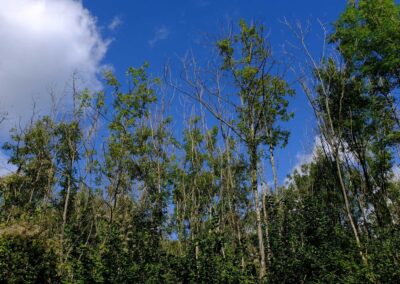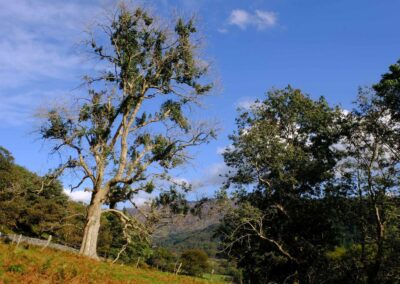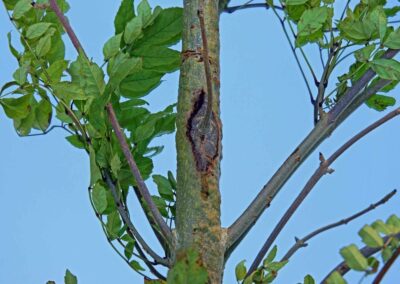Latest News
Ash Dieback - The Time to Act Is NowAlfie Allingham, Operations Manager at Forest Direct, explores why landowners and managers need to take the threat of Ash Dieback seriously and why it isn’t just the wellbeing of the tree we need to worry about.
In recent months we have seen increasing noise in the media around the risk of felling diseased trees – the BBC recently spoke of ‘exploding diseased trees’ . Although this may sound somewhat dramatic, the reality isn’t far off it.
Ash Dieback, also called Chalara Ash Dieback, is a fungal disease which originated in Asia, and its introduction to Europe has devastated the European ash. It is estimated that 95 per cent of the UK ash tree population will be affected by the disease, and, despite ongoing scientific research, there is currently no cure or treatment.
Landowners and farmers now find themselves with a public safety responsibility, which with Scotland’s right to roam legislation can include all areas of their landholding. The legal position is that the owner of the land where a tree stands is responsible for the safety of that tree and the wellbeing of those who could be affected by it. Liabilities can arise if trees or branches fall. So, it is vital that landowners and managers can recognise the symptoms of Ash Dieback so they can deal with trees which pose a risk.
Woodlands Insurance expert Rory Gibson from Lycetts Insurance Brokers points out that there are a number of potential pitfalls in neglecting your tree safety obligations. Whilst all landowners and even homeowners will likely have public liability insurance covering the dangers posed by their property, trees included, to third parties and members of the public this is not to say the cover will automatically respond in the event of a loss.
There are two key conditions of cover that are where most unsuccessful claims come unstuck;
1. The insured must act in accordance with the law at all times – In this case property owners are legally obliged to conduct safety inspections on their trees and as such failure to do so could result in a claim being repudiated.
2. Liability claims are based on negligence, therefore in order for a claim to be validated there must be negligence, that doesn’t equate to a breach in your legal requirements.
Both these point bringing us back to the fact it is essential to undertake tree surveys and actively manage your woodland, something that have been exaggerated by Ash Dieback.
So what are we looking for?
Ash dieback causes a range of symptoms, including wilted and spotted leaves. Most affected ash trees will lose some of the leaves at the top of the tree – its crown. However, ash dieback can affect trees in different ways – for example, some may develop dark patches called ‘basal lesions’ at the base of their trunk but have no sign of ash dieback in their leaves and branches.
Stages of dieback
CLASS 1 100%–76% of the crown remains
CLASS 2 75%–51% of the crown remains
CLASS 3 50%–26% of the crown remains
CLASS 4 25%–0% of the crown remains
The following resources are available to help identify whether any of your Ash trees are a risk. Still, we would reinforce that if you are at all unsure, you should consult a professional tree surveyor.
Scottish Forestry – https://forestry.gov.scot/sustainable-forestry/tree-health/tree-pests-and-diseases/chalara-ash-dieback
The Tree Council – https://www.gov.im/media/1369611/tree-council-ash-dieback-tree-owners-guide-final.pdf
Forest Direct currently has six full-time tree surveyors working across Scotland and the north of England; we have broad experience in dealing with Ash Dieback and are fully insured. Once formally identified, our team are also trained in the safe removal of the tree avoiding risk to the health and safety of you, your team and the general public.
In addition to the physical management of trees, it is also imperative your paperwork is up to date with risk assessments conducted regularly and logged. Health and Safety is something Forest Direct take very seriously, and we are also able to support you in your ongoing forestry management, including health and Safety.
In addition, landowners should remember that felling trees, even those with a disease, is likely to require a felling licence from Scottish Forestry. Although exemptions do apply “where necessary for the prevention of immediate danger to persons or to property.”
More information on exemptions can be found here
Health and Safety is our main priority; however there is also a financial implication to be considered; the further the disease has spread through the tree, the more complex and more costly felling can be, the risks become more significant and the requirement for more machinery is expected.
This is the time of year to be looking out for signs of Ash Dieback and it can change very quickly between stages and is important to monitor your trees especially along roads or high use public areas.
The quicker it is dealt with the less cost incurred by the client and the more for a potential return on timber sales. If you would like to hear more about how Forest Direct can support your management of Ash Dieback please get in touch



